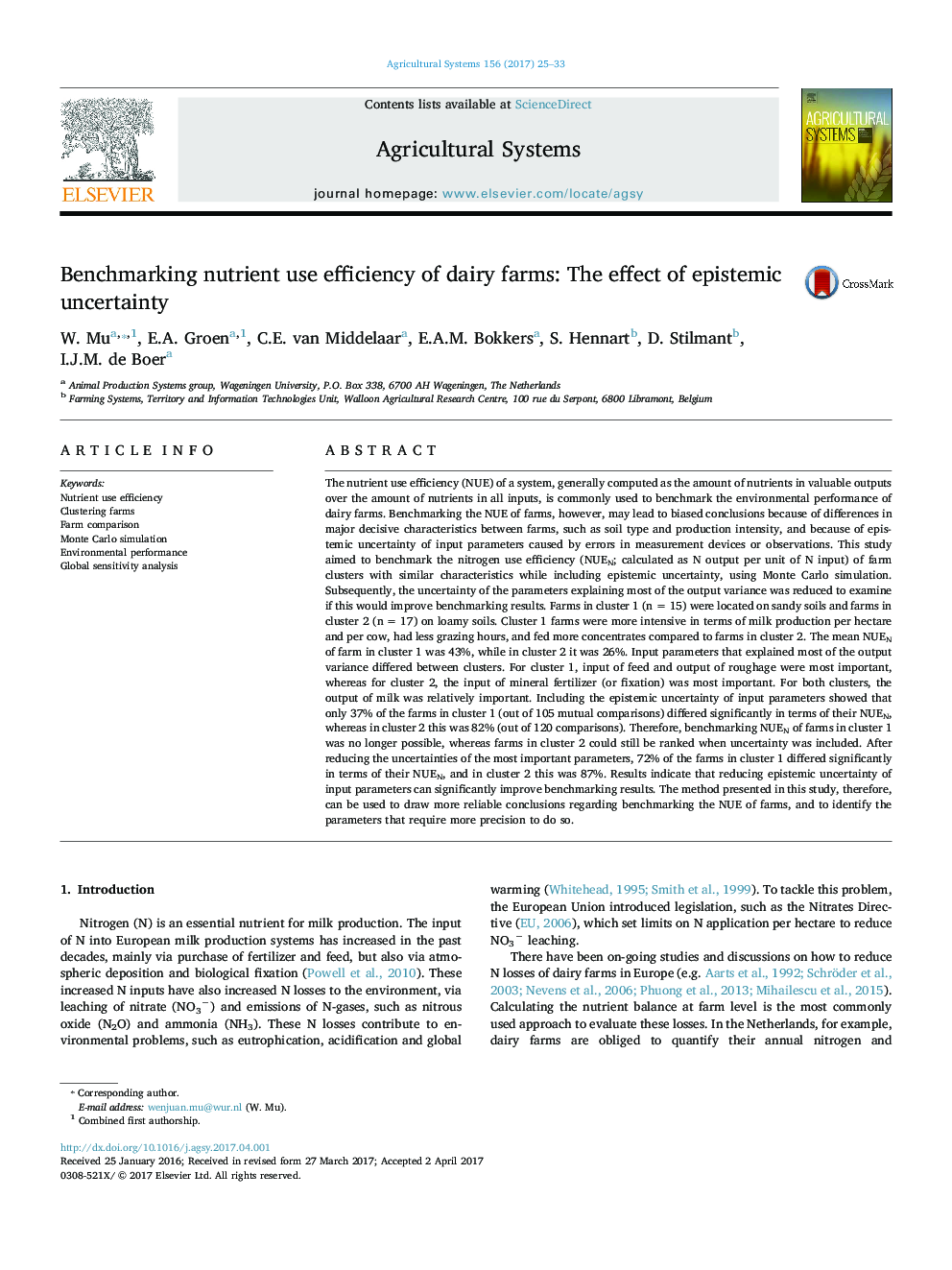| کد مقاله | کد نشریه | سال انتشار | مقاله انگلیسی | نسخه تمام متن |
|---|---|---|---|---|
| 5759690 | 1623214 | 2017 | 9 صفحه PDF | دانلود رایگان |
عنوان انگلیسی مقاله ISI
Benchmarking nutrient use efficiency of dairy farms: The effect of epistemic uncertainty
ترجمه فارسی عنوان
ارزیابی کارایی استفاده از مواد مغذی مزارع لبنی: تأثیر عدم قطعیت معرفتی
دانلود مقاله + سفارش ترجمه
دانلود مقاله ISI انگلیسی
رایگان برای ایرانیان
کلمات کلیدی
بهره وری استفاده از مواد مغذی، خوشه بندی مزارع، مقایسه مزرعه، شبیه سازی مونت کارلو، عملکرد زیست محیطی، تجزیه و تحلیل حساسیت جهانی،
موضوعات مرتبط
علوم زیستی و بیوفناوری
علوم کشاورزی و بیولوژیک
علوم کشاورزی و بیولوژیک (عمومی)
چکیده انگلیسی
The nutrient use efficiency (NUE) of a system, generally computed as the amount of nutrients in valuable outputs over the amount of nutrients in all inputs, is commonly used to benchmark the environmental performance of dairy farms. Benchmarking the NUE of farms, however, may lead to biased conclusions because of differences in major decisive characteristics between farms, such as soil type and production intensity, and because of epistemic uncertainty of input parameters caused by errors in measurement devices or observations. This study aimed to benchmark the nitrogen use efficiency (NUEN; calculated as N output per unit of N input) of farm clusters with similar characteristics while including epistemic uncertainty, using Monte Carlo simulation. Subsequently, the uncertainty of the parameters explaining most of the output variance was reduced to examine if this would improve benchmarking results. Farms in cluster 1 (n = 15) were located on sandy soils and farms in cluster 2 (n = 17) on loamy soils. Cluster 1 farms were more intensive in terms of milk production per hectare and per cow, had less grazing hours, and fed more concentrates compared to farms in cluster 2. The mean NUEN of farm in cluster 1 was 43%, while in cluster 2 it was 26%. Input parameters that explained most of the output variance differed between clusters. For cluster 1, input of feed and output of roughage were most important, whereas for cluster 2, the input of mineral fertilizer (or fixation) was most important. For both clusters, the output of milk was relatively important. Including the epistemic uncertainty of input parameters showed that only 37% of the farms in cluster 1 (out of 105 mutual comparisons) differed significantly in terms of their NUEN, whereas in cluster 2 this was 82% (out of 120 comparisons). Therefore, benchmarking NUEN of farms in cluster 1 was no longer possible, whereas farms in cluster 2 could still be ranked when uncertainty was included. After reducing the uncertainties of the most important parameters, 72% of the farms in cluster 1 differed significantly in terms of their NUEN, and in cluster 2 this was 87%. Results indicate that reducing epistemic uncertainty of input parameters can significantly improve benchmarking results. The method presented in this study, therefore, can be used to draw more reliable conclusions regarding benchmarking the NUE of farms, and to identify the parameters that require more precision to do so.
ناشر
Database: Elsevier - ScienceDirect (ساینس دایرکت)
Journal: Agricultural Systems - Volume 156, September 2017, Pages 25-33
Journal: Agricultural Systems - Volume 156, September 2017, Pages 25-33
نویسندگان
W. Mu, E.A. Groen, C.E. van Middelaar, E.A.M. Bokkers, S. Hennart, D. Stilmant, I.J.M. de Boer,
